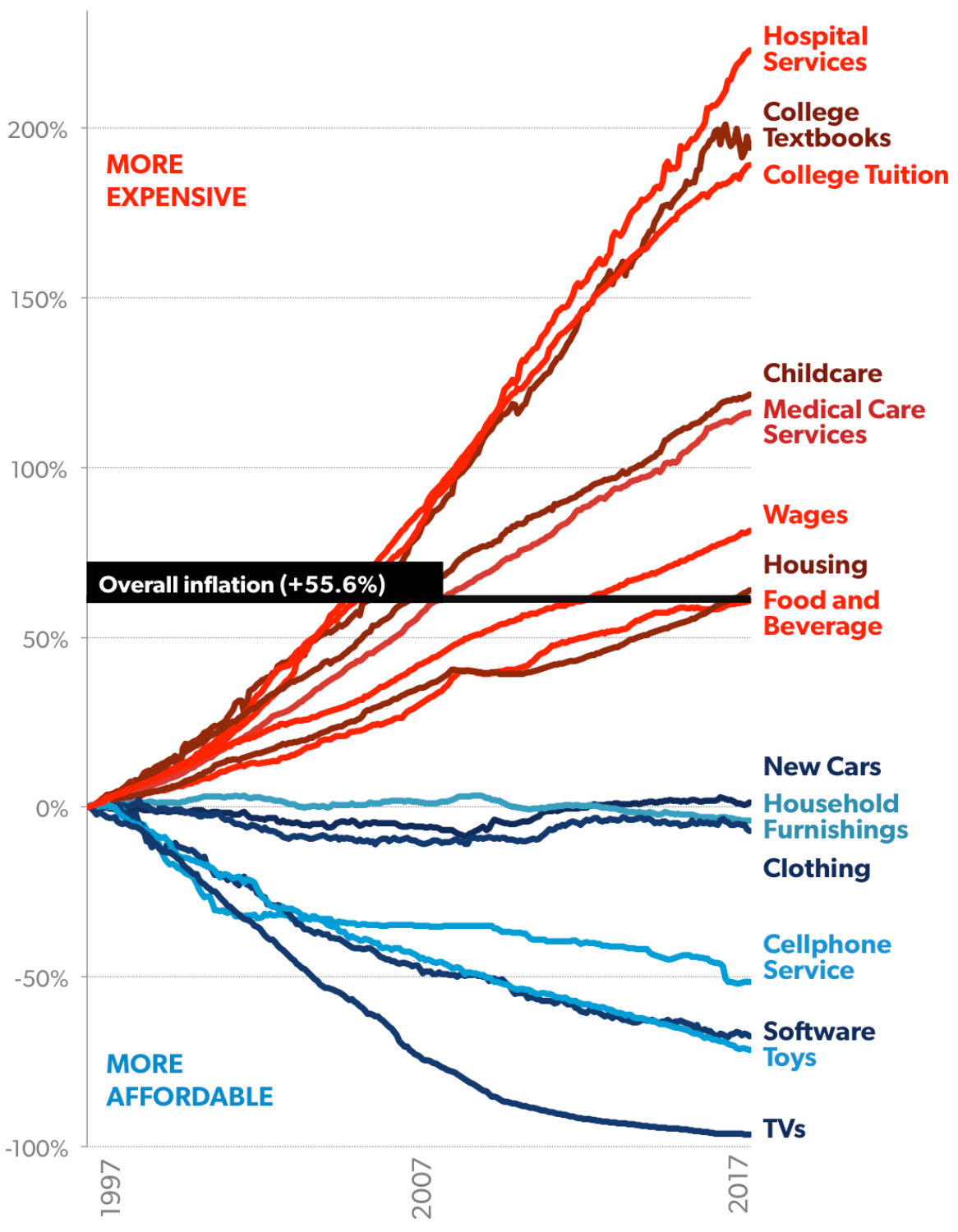There’s a famous chart of cumulative inflation from the late 90s to the present, broken down by sector:

Usually, the emphasis is on the parts that grew: healthcare, education, childcare, housing. How you interpret this depends on your beliefs: libertarians note that these are sectors with intense government involvement; progressives and National Conservatism types note that these are all disproportionately important purchases for the actual and aspirational middle-class; economics wonks point out that the highest-inflation goods are nontradable.
But the bottom of the chart deserves attention, too, and we should give the wonks their due: one reason gadgets are getting cheaper is that they’re rapidly improving, but another big reason is trade. China’s labor force at the start of that chart was 718 million; it would rise 783m by the end. In 1998, China’s GDP per capita was a little over $800, and the state’s highest priority was creating 25m jobs each year to control unemployment.
(The gap between labor force growth and job creation needs was driven by China’s rapid urbanization; city-dwellers were 34% of the population in 1998 and are now 60%.)
Part of the globalization story, until very recently, has been the almost unlimited elasticity of China’s labor force, which persistently drove down the prices and ramped up the volumes of any product that could fit into a shipping container. This has had some important side effects—not just de-industrialization in the US and Europe, but a Long Deflation in the price of consumer goods.
Now it’s coming to an end. China’s labor force has peaked, the country is (optimistically) moving towards a growth model driven by consumption rather than export or (pessimistically) sliding back into autarky, and disruptions from the trade war and now Covid-19 have strained links between Chinese suppliers and Western consumers.
There’s evidence that consumers have been too well-trained to expect stable prices. For example, consider the phenomenon of “shrinkflation”: companies pick a small number of price points, and adjust products until they fit those price points. The smooth curves of a traditional supply and demand graph have been replaced by jagged step-functions.
A more recent example is the great kettlebell shortage of 2020. Kettlebells are hard to transport, because they’re heavy, that being the point of a kettlebell. US demand perked up before Chinese factories came back on line (or at least before the shipments arrived), so US factories—with US wage scales and cost structures—have picked up some of the slack. The Econ 101 expectation is that a supply shortage plus a demand spike should cause much higher prices; if Homo Economicus wants a kettlebell, he’d better pay up. That’s not exactly what’s happening: Rogue Fitness sells 70lb kettlebells for $93 today, compared to $86 in October, not exactly price-gouging. On Amazon, you can buy a 70lb kettlebell for $130—but not from Amazon, from third-party sellers instead.[1]
What seems to be happening is that we have a two-tier price system. Third-party sellers aggregated by Amazon are indifferent to customers' price expectations. Rogue Fitness is not; it knows the best customers are repeat buyers, and that they’ve been conditioned to expect stable prices.
Pre-China Shock, the way inflation showed up was in price spikes for goods like clothing and appliances. In the last few decades, inflation has taken the form of relentless price increases in nontradable sectors, and up-and-down volatility in food and energy. While the slow end of the Great Deflation won’t necessarily lead to widespread inflation—that still depends on growth in demand, which will have to overcome short-term epidemic hurdles and two decades of challenging demographics—it will change the shape of inflation. We aren’t going back to the 1970s, but in inflationary terms we are going back to the mid-twentieth century, when supply and demand had roughly the same relationship you’d see in an economics textbook.
[1] I’ve omitted shipping to simplify, but I will note that it’s a big factor: I price-compared between Amazon and a brick-and-mortar store when I bought a kettlebell, and realized I could save $25 or so by buying it in person. So I did, walked a block, and realized the only way I’d get the kettlebell home was by taking Uber. It worked out to about $25, too. Market efficiency wins again.
Covid-19 Updates
- Airbnb expects revenue to decline 54% this year, with a rapid rebound in 2021 (edit: original version said 2020). I noted yesterday that Airbnb hosts are listing properties on long-term rental sites; Airbnb is now offering features that encourage longer-term stays. Extended-stay hotels are a smaller share of the US hotel market than extended stays are of US hotel room-nights, so this is not just an opportunistic move.
- Two new datasets on SMBs: ThumbTack is tracking home services businesses by region and category, showing roughly the trends one would expect—though a comparison to OpenTable’s data indicates that New York and SF are leading indicators. And GoDaddy is tracking small online businesses around the country.
- Yesterday I argued that pure black swan funds do worse than opportunistic funds that pay attention to negative catalysts, because hedging is expensive. That assertion immediately collided with a black swan of its own: Universa Investments' tail risk fund was up 36x in March. Perhaps that’s what they did; Taleb was certainly alarmed early.
- Mule at Mule’s Musings (I strongly recommend you subscribe) pieces together evidence of the upcoming adpocalypse. The short version: advertising spend changes about 1.5x as fast as GDP; the 2008 comparison is not relevant because digital spend as a percentage of time-spent was so low, but now it’s in-line. Consensus estimates for ad-driven companies call for flattish revenue growth in Q2; Mule thinks it’s more like -20%.
- More backstory on the COBOL programmer shortage. I’ve noted before that COBOL programmers' demographics lead to some odd outcomes.
- Covid-19 has led to an increase in desktop traffic rather than mobile traffic, which benefits a handful of companies that are a few years behind the curve, and has strong implications about how much phone-based procrastination people engage in at work. Maybe in another ten or twenty years, accessing social media during work hours will be about as socially acceptable as the three-martini lunch.
Elsewhere
Zoom Wins and Loses
Google has banned employees from using Zoom, a very negative datapoint for a company that relies on network effects (the rebrand of Google’s competing product is doubtless a coincidence). But Zoom has hired Alex Stamos as a security consultant. Stamos has an excellent reputation, but it’s a strong signal that they plan to tighten up fast: Stamos left Yahoo when they let the government read some users' emails. He joined Facebook, and after quitting there called for Mark Zuckerberg to resign. This is a massive reputational Bug Bounty on Zoom’s part.

 Byrne Hobart
Byrne Hobart